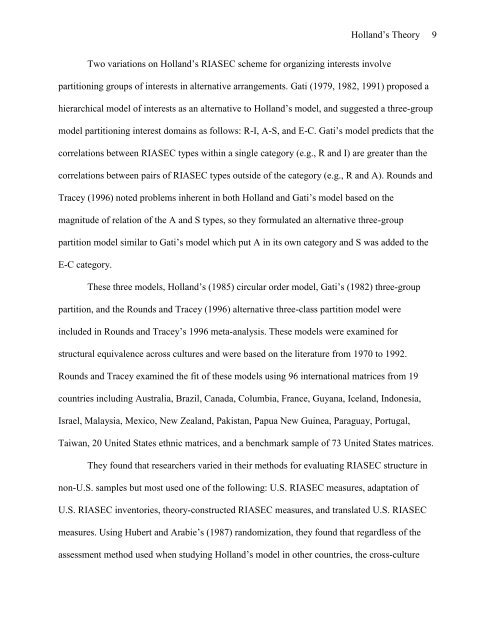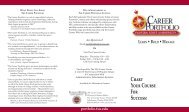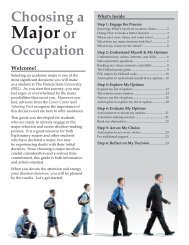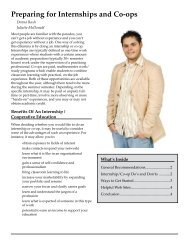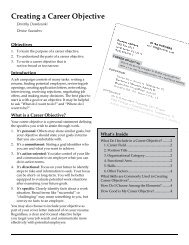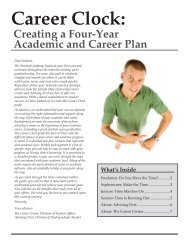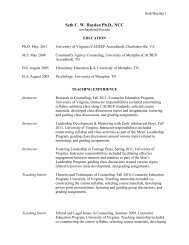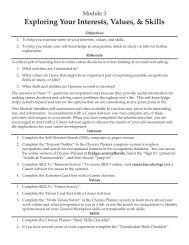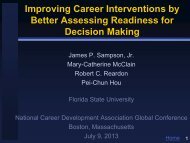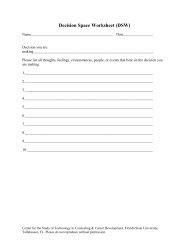Holland's Theory in a Post-Modern World: - The Career Center ...
Holland's Theory in a Post-Modern World: - The Career Center ...
Holland's Theory in a Post-Modern World: - The Career Center ...
You also want an ePaper? Increase the reach of your titles
YUMPU automatically turns print PDFs into web optimized ePapers that Google loves.
Holland’s <strong><strong>The</strong>ory</strong> 9Two variations on Holland’s RIASEC scheme for organiz<strong>in</strong>g <strong>in</strong>terests <strong>in</strong>volvepartition<strong>in</strong>g groups of <strong>in</strong>terests <strong>in</strong> alternative arrangements. Gati (1979, 1982, 1991) proposed ahierarchical model of <strong>in</strong>terests as an alternative to Holland’s model, and suggested a three-groupmodel partition<strong>in</strong>g <strong>in</strong>terest doma<strong>in</strong>s as follows: R-I, A-S, and E-C. Gati’s model predicts that thecorrelations between RIASEC types with<strong>in</strong> a s<strong>in</strong>gle category (e.g., R and I) are greater than thecorrelations between pairs of RIASEC types outside of the category (e.g., R and A). Rounds andTracey (1996) noted problems <strong>in</strong>herent <strong>in</strong> both Holland and Gati’s model based on themagnitude of relation of the A and S types, so they formulated an alternative three-grouppartition model similar to Gati’s model which put A <strong>in</strong> its own category and S was added to theE-C category.<strong>The</strong>se three models, Holland’s (1985) circular order model, Gati’s (1982) three-grouppartition, and the Rounds and Tracey (1996) alternative three-class partition model were<strong>in</strong>cluded <strong>in</strong> Rounds and Tracey’s 1996 meta-analysis. <strong>The</strong>se models were exam<strong>in</strong>ed forstructural equivalence across cultures and were based on the literature from 1970 to 1992.Rounds and Tracey exam<strong>in</strong>ed the fit of these models us<strong>in</strong>g 96 <strong>in</strong>ternational matrices from 19countries <strong>in</strong>clud<strong>in</strong>g Australia, Brazil, Canada, Columbia, France, Guyana, Iceland, Indonesia,Israel, Malaysia, Mexico, New Zealand, Pakistan, Papua New Gu<strong>in</strong>ea, Paraguay, Portugal,Taiwan, 20 United States ethnic matrices, and a benchmark sample of 73 United States matrices.<strong>The</strong>y found that researchers varied <strong>in</strong> their methods for evaluat<strong>in</strong>g RIASEC structure <strong>in</strong>non-U.S. samples but most used one of the follow<strong>in</strong>g: U.S. RIASEC measures, adaptation ofU.S. RIASEC <strong>in</strong>ventories, theory-constructed RIASEC measures, and translated U.S. RIASECmeasures. Us<strong>in</strong>g Hubert and Arabie’s (1987) randomization, they found that regardless of theassessment method used when study<strong>in</strong>g Holland’s model <strong>in</strong> other countries, the cross-culture


